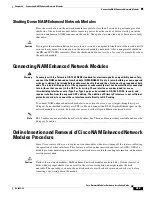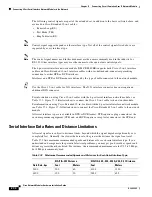
27-4
Cisco Network Modules Hardware Installation Guide
OL-2485-20
Chapter 27 Connecting Circuit Emulation Over IP Network Modules
Connecting 4-Port Serial Interface Network Modules to the Network
The following control signals are part of the extended set, in addition to the basic set listed above, and
are used on Cisco Extended 12-in-1 cables:
•
Remote Loop (RL)
•
Test Mode (TM)
•
Ring Indicator (RI)
Note
Control signal support depends on the interface type. Not all of the control signals listed above are
supported by every interface type.
Note
The control signal names used in this document are the names commonly used in the industry for
RS-232. Other interface types may use other names for the equivalent control signals.
The 4-port serial interface network module (NM-CEM-4SER) supports both Cisco 12-in-1 interface
cables and Cisco Extended 12-in-1 interface cables with user-defined end-connectors permitting
connection to either DTE or DCE interfaces.
Interfaces and DTE or DCE modes are defined by the type of cable connected to the network module.
Tip
Use the Cisco 12-in-1 cable for X.21 interfaces. The X.21 interface connector does not require an
additional DIN connector.
For information on using Cisco 12-in-1 cables with the 4-port serial interface network module, see
Table 27-3
.
Figure 27-4
illustrates how to connect the Cisco 12-in-1 cable to the network module.
For information on using Cisco Extended 12-in-1 cables with the 4-port serial interface network module,
see
Table 27-4
.
Figure 27-5
illustrates how to connect the Cisco Extended 12-in-1 cable to the network
module.
All serial interface types are available in DTE or DCE format: DTE requires a plug connector at the
customer premises equipment (CPE) end, and DCE requires a receptacle connector at the CPE end.
Serial Interface Data Rates and Distance Limitations
All serial signals are subject to distance limits, beyond which the signal degrades significantly or is
completely lost. Generally, the slower the data rate, the greater the distance the signal can travel.
Table 27-2
lists maximum recommended speeds and distances for each serial interface type. If you
understand and compensate for potential electrical problems, you may get good results at speeds and
distances greater than those listed. For instance, the recommended maximum rate for V.35 is 2 Mbps,
but 4 Mbps is commonly used.
Table 27-2
Maximum Recommended Speeds and Distances for Each Serial Interface Type
EIA/TIA-232 Distance
EIA/TIA-449, -530, -530A, V.35, X.21 Distance
Data Rate, bps
Feet
Meters
Feet
Meters
2400
200
60
4100
1250
4800
100
30
2050
625
















































